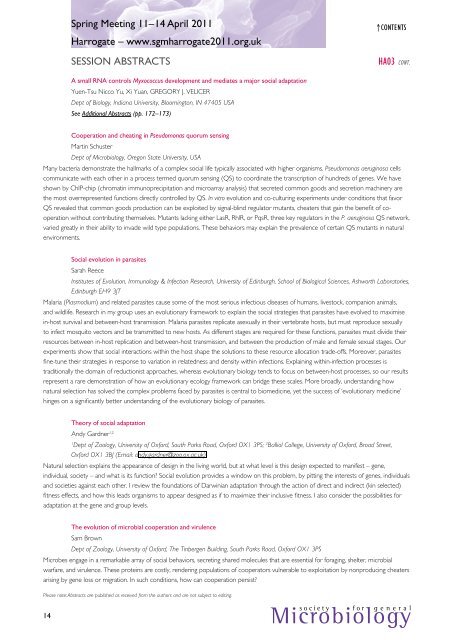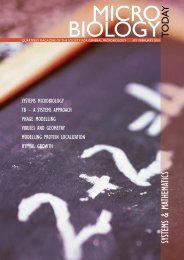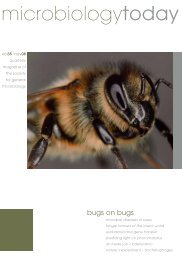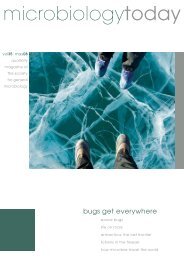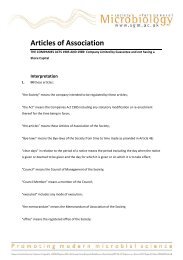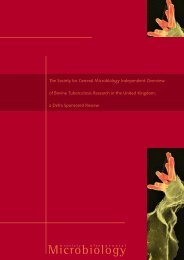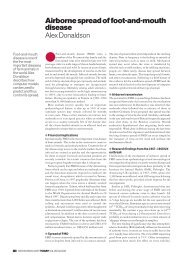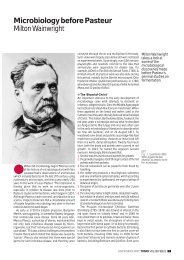Spring Conference 2011 - Society for General Microbiology
Spring Conference 2011 - Society for General Microbiology
Spring Conference 2011 - Society for General Microbiology
Create successful ePaper yourself
Turn your PDF publications into a flip-book with our unique Google optimized e-Paper software.
Please note: Abstracts are published as received from the authors and are not subject to editing.<br />
14<br />
<strong>Spring</strong> Meeting 11–14 April <strong>2011</strong><br />
Harrogate – www.sgmharrogate<strong>2011</strong>.org.uk<br />
SESSION AbSTrACTS<br />
A small rNA controls Myxococcus development and mediates a major social adaptation<br />
Yuen-Tsu Nicco Yu, xi Yuan, GrEGOrY J. VEliCEr<br />
Dept of Biology, Indiana University, Bloomington, IN 47405 USA<br />
See Additional Abstracts (pp. 172–173)<br />
↑Contents<br />
HA03 Cont.<br />
Cooperation and cheating in Pseudomonas quorum sensing<br />
Martin Schuster<br />
Dept of <strong>Microbiology</strong>, Oregon State University, USA<br />
Many bacteria demonstrate the hallmarks of a complex social life typically associated with higher organisms. Pseudomonas aeruginosa cells<br />
communicate with each other in a process termed quorum sensing (QS) to coordinate the transcription of hundreds of genes. We have<br />
shown by ChiP-chip (chromatin immunoprecipitation and microarray analysis) that secreted common goods and secretion machinery are<br />
the most overrepresented functions directly controlled by QS. In vitro evolution and co-culturing experiments under conditions that favor<br />
QS revealed that common goods production can be exploited by signal-blind regulator mutants, cheaters that gain the benefit of cooperation<br />
without contributing themselves. Mutants lacking either lasr, rhlr, or Pqsr, three key regulators in the P. aeruginosa QS network,<br />
varied greatly in their ability to invade wild type populations. These behaviors may explain the prevalence of certain QS mutants in natural<br />
environments.<br />
Social evolution in parasites<br />
Sarah reece<br />
Institutes of Evolution, Immunology & Infection Research, University of Edinburgh, School of Biological Sciences, Ashworth Laboratories,<br />
Edinburgh EH9 3JT<br />
Malaria (Plasmodium) and related parasites cause some of the most serious infectious diseases of humans, livestock, companion animals,<br />
and wildlife. research in my group uses an evolutionary framework to explain the social strategies that parasites have evolved to maximise<br />
in-host survival and between-host transmission. Malaria parasites replicate asexually in their vertebrate hosts, but must reproduce sexually<br />
to infect mosquito vectors and be transmitted to new hosts. As different stages are required <strong>for</strong> these functions, parasites must divide their<br />
resources between in-host replication and between-host transmission, and between the production of male and female sexual stages. Our<br />
experiments show that social interactions within the host shape the solutions to these resource allocation trade-offs. Moreover, parasites<br />
fine-tune their strategies in response to variation in relatedness and density within infections. Explaining within-infection processes is<br />
traditionally the domain of reductionist approaches, whereas evolutionary biology tends to focus on between-host processes, so our results<br />
represent a rare demonstration of how an evolutionary ecology framework can bridge these scales. More broadly, understanding how<br />
natural selection has solved the complex problems faced by parasites is central to biomedicine, yet the success of ‘evolutionary medicine’<br />
hinges on a significantly better understanding of the evolutionary biology of parasites.<br />
Theory of social adaptation<br />
Andy Gardner1,2 1 2 Dept of Zoology, University of Ox<strong>for</strong>d, South Parks Road, Ox<strong>for</strong>d OX1 3PS; Balliol College, University of Ox<strong>for</strong>d, Broad Street,<br />
Ox<strong>for</strong>d OX1 3BJ (Email: andy.gardner@zoo.ox.ac.uk)<br />
Natural selection explains the appearance of design in the living world, but at what level is this design expected to manifest – gene,<br />
individual, society – and what is its function? Social evolution provides a window on this problem, by pitting the interests of genes, individuals<br />
and societies against each other. i review the foundations of Darwinian adaptation through the action of direct and indirect (kin selected)<br />
fitness effects, and how this leads organisms to appear designed as if to maximize their inclusive fitness. i also consider the possibilities <strong>for</strong><br />
adaptation at the gene and group levels.<br />
The evolution of microbial cooperation and virulence<br />
Sam Brown<br />
Dept of Zoology, University of Ox<strong>for</strong>d, The Tinbergen Building, South Parks Road, Ox<strong>for</strong>d OX1 3PS<br />
Microbes engage in a remarkable array of social behaviors, secreting shared molecules that are essential <strong>for</strong> <strong>for</strong>aging, shelter, microbial<br />
warfare, and virulence. These proteins are costly, rendering populations of cooperators vulnerable to exploitation by nonproducing cheaters<br />
arising by gene loss or migration. in such conditions, how can cooperation persist?<br />
s o c i e t y f o r g e n e r a l<br />
<strong>Microbiology</strong>


